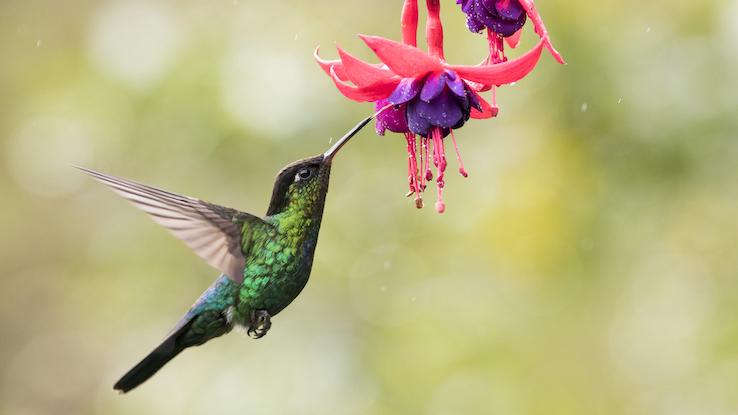How Hummingbird Trackers Map Hummingbird Migration Patterns

It’s been yet another great hummingbird tracking season for both new and seasoned hummingbird enthusiasts. Take a look at hummingbird trackers, how they work and the scientific benefits they offer researchers. We’ll also explore hummingbirds’ migratory patterns, migration timelines, and the processes of attracting more hummingbirds to your garden while making your garden more habitable for them.
What Is Hummingbird Tracking?
Hummingbirds are tiny birds with long, slender beaks designed for feeding on the nectar of tubular flowers. They are only found in the Western Hemisphere, with only a few dozen species spending the winter in Central America or Mexico. After that, they fly from the southern United States towards their breeding grounds in the north from late January or February. Later in the spring, they migrate farther north and may be seen in Canada’s breeding grounds.
Hummingbird tracking can be done through a website or an app that displays the migratory patterns of hummingbirds across the United States and Canada. To help track their migration, sites like Hummingbird Central host a publicly accessible Hummingbird Migration Map. Each year the site updates the interactive map with viewer-submitted sightings throughout the spring, as hummingbirds fly on, often between late January and mid-May.
How Does a Hummingbird Tracker Work?
Every year during the winter, hummingbirds fly across states to warmer parts of the United States and Canada. A hummingbird tracker works with the help of viewers’ sightings of these birds in specific areas.
Once viewers spot their first sighting of hummingbirds from non-breeding sites, they fill out a form that includes details of the sighting date, the viewers’ city, state, ZIP code and the species type out of the 15 most common hummingbirds in North America. However, submissions are not instantly viewable on the map, as they are updated periodically throughout the day.

The hummingbirds’ eventual destination changes yearly, depending on weather and environmental factors. As a result, scientists and hummingbird enthusiasts always look forward to tracking the migratory patterns each year.
In the fall, Hummingbird Central’s Migration Map & Sightings also track migration patterns. This usually begins in August or September, when the hummingbirds start their journey south.
Scientific Benefits of a Hummingbird Tracker
Hummingbirds are like any other animal; they need food and water to survive. They range in size from 3 to 5 inches. During migration, their hearts beat up to 1,260 times every minute, and their wings flap 15 to 80 times each second, according to Hummingbird Central. For a tiny bird, hummingbirds need a high energy supply to keep up. This is why they gain 25 to 40% of their body weight before migrating north, and why they often fly during the day when the flowers are in bloom.
To ensure that hummingbirds make their way across the southern United States safely, users track the hummingbirds’ migration patterns. They also set out feeders two weeks before the birds arrive, ensuring the birds will have plenty of energy for their journey.
Furthermore, scientists use a tiny RFID chip — the size of a ladybug — to monitor hummingbird migration patterns. This technology is similar to microchipping your pet. Consequently, scientists can monitor the birds’ health, and study disease transmission.
How to Attract More Hummingbirds to Your Garden
If you’re wondering how you can attract more hummingbirds to your garden, here’s a quick hummingbird guide on how to help draw them in.
Nowadays, feeders are incorporating the color red into their designs. They’ve discovered that red sparks a thrilling interest for the birds. Alternatively, you can either plant red flowers in your garden or throw some red ribbons over your feeder to make sure hummingbirds make a stopover in your yard.

Hummingbirds feed on nectar from flowers with bright red, tubular shapes. If you’re wondering about the specific species to plant in your garden, consider a few plants:
- Salvia
- Pentas
- Zinnias
- Lantana
- Milkweed
- Bat face Cuphea
Any of these plants should attract hummingbirds.
As much as hummingbirds need food, they also value shelter and protection. You can ensure hummingbirds stick around between meals when dense foliage of trees and large shrubs are in your garden. This helps provide safety and attracts insects that are an alternative food source.
You want hummingbirds to have a visit to your garden before resuming their journey. So, don’t forget to provide them with water for drinking and bathing. Although the widespread assumption is that the water and homemade sugar nectar in the feeders are enough, hummingbirds also need fresh water on hot afternoons. Feel free to add gently flowing water or a solar-powered birdbath for a cooling dip and a refreshing drink.
Aside from nectar, hummingbirds rely on insects for protein. Having a feeder is a great way to ensure your garden is visited by these wonderful birds. Place old banana peels by the feeder to attract fruit flies. Hummingbirds love fruit flies and may stop by for a meal. Once you have these essentials set up, you’ll hopefully be able to enjoy a garden full of beautiful hummingbirds.





